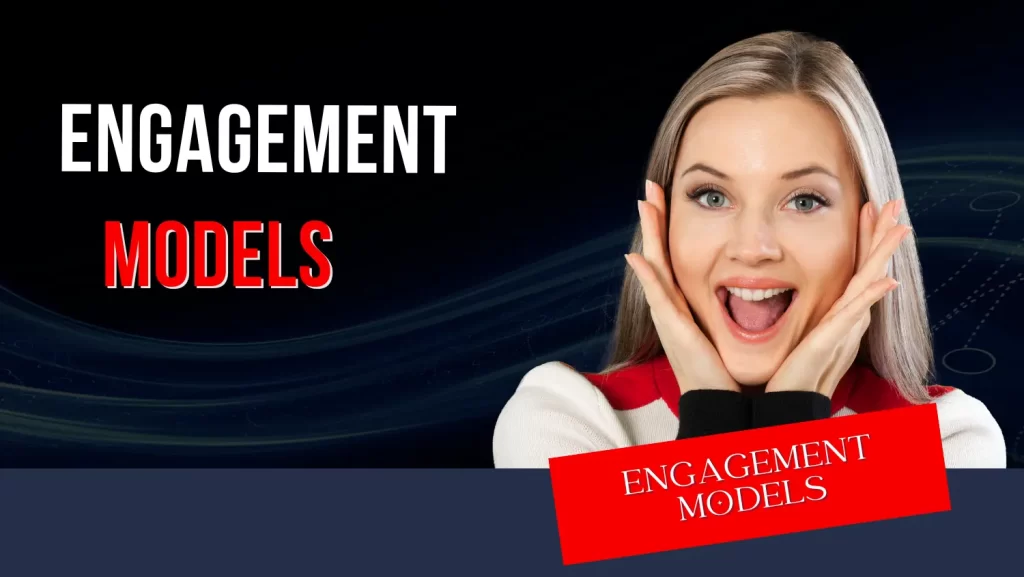Software development involves a variety of engagement models. Companies can use these engagement structures to understand the kind of business dynamics they want to engage in.
A project engagement model involves team structuring to develop a product or software.
Currently, companies are looking for smart, cost-effective, and agile ways to develop better software products. Engagement models such as these emphasize the best staff augmentation arrangements for businesses in 2023 and beyond.
Engagement Models: What are they?
Engagement Model Types
The following are some types of engagement models.
- Model of Time and Materials
- Model with a fixed price
- Model of a dedicated team
- Model of an extended team
Let’s take a closer look at these engagement models and their benefits for businesses.
An overview of the time and materials model
In terms of IT outsourcing, this is an interesting engagement model. It provides companies with a general understanding of the business requirements and the total time required for the development process. The project team is looking for resources (either dedicated or extended).
After that, the development team begins working on the project on a daily basis. Each IT resource’s rate is also predetermined. In the same way, you should also account for the total number of hours worked.
It is possible to allocate 50% of the technology resources in a time-and-materials (T&M) engagement. They will work for 4 hours a day until their allocation is exhausted.
A T&M contract allows flexibility in roping in resources as needed and removing them when needed. Therefore, you pay on the spot for the hired services.
What are the benefits of using a Time and Materials Model?
The time and materials model has many advantages, including:
- Projects where requirements can be changed without having too much knowledge about what needs to be done are ideal for it.
- The resource activities are more accountable to you, so you can question the output if it is not what you expected.
- With the help of industry experts, you can shape up project requirements and deal with unforeseen situations.
- Rather than paying a lump sum, you only pay for the services rendered.
- Once the project is complete and deliverables are in hand, T&M engagements can be terminated easily.
Model with a fixed price
The fixed price model is probably the most popular team engagement structure. There are many names for fixed time, fixed scope, fixed cost, and fixed bid. However, they all mean the same thing.
In this model, you have explored the market to a high degree of certainty. In addition, you are certain of what you want, without facing any major obstacles. It allows you to describe the project scope clearly.
An elaborated scope defines the project’s time and cost among the triple constraints of project management. Eventually, you will understand what the project timelines are and how many resources are required. Consequently, the quality of the software project under development is greatly enhanced.
Also, you can see how flexible you are when it comes to launching the MVP. Adding more resources can accelerate the delivery time for the software solution by fast-tracking the project.
What are the places where fixed price models are used?
Fixed price models have many returns, including:
- You can use it for projects where you have a great deal of visibility into the requirements of the project.
- By controlling the execution, the breakdown of the work, and how the resources will work on activities, you are in control of the entire project.
- If you choose to orchestrate your project in a waterfall, iteration, or agile manner, it is easy to do so. The culture of your company and how you work in your industry also play a role in this. Then, you can launch software projects on time and in a timely manner.
- By continuously gauging project velocity and resource performance, you will be able to steer the project to ensure that it does not derail.

Engagement Model Types
Model of a dedicated team
The dedicated team model (DTM) describes how resources will be associated with you. A DTM engagement model blends well with fixed price or T&M projects. You are therefore able to run the business as a whole with the help of a dedicated team.
Your project can be completely outsourced, or a team can be recruited for it. Among them are business analysts, designers, front-end developers, back-end coders, full-stack programmers, and quality assurance staff. As well, you can contract resources based on your needs.
Businesses without IT professionals benefit from this. Dedicated resources can be hired or a third-party technology firm can be subcontracted to provide a whole team of experts. Using the exclusive IT staff that is not fully contracted, they can develop web-based or mobile-based solutions.
When should a dedicated team model be used?
The dedicated team model has many advantages, including:
- You should hire dedicated developers for projects where you just want to monitor project execution hassle-free.
- By scheduling 1-1 progress meetings on a specific recurrence, you can have complete transparency.
- A hired IT agency is responsible for all aspects of the project, including the associated risks.
- With international companies, you can minimize overhead costs (hiring, training, medical, etc.).
Model of an extended team
The extended team model (ETM) is also an attachment to a fixed-price or time-and-materials project. Rather than hiring a full-on team, you hire a bunch of IT resources to become your extensions. The team extension model (TEM) is also known as this.
You may have software developers in-house, but there is no one to do quality assurance. As a result, you can extend your development team with QA resources. Your team will then temporarily include them.
Why should you opt for the Extended Team Model?
The extended team model has many benefits, including:
- Regardless of their demographics, it helps you assemble the best IT team.
- Working closely with an in-house team and monitoring a remote extended team, you remain in charge.
- Because outsourced members of the extended team are located remotely, you don’t incur overhead costs.
- Define the project team’s WBS, tasks, and activities to lead the way.
Select the right Team Engagement for your next software project
In conclusion
For 2023, you need to know your business needs, project scope, budget, and timeline. The rest is taken care of by your engagement model.
All engagement models have their pros and cons when it comes to software projects. The dedicated team model and fixed price model are preferred by many companies that require IT resources. Time and materials models and extended team models are also popular and have various applications.
Do you want to start a software project but do not know where to begin? Set up the best team appointment through Techliance today. Now is the time to embark on your next software project endeavor through IT solution provider subcontracting.




Leave A Comment